
The Model T is an example of the object being constructed of many parts in which the sum of the parts exceeds the cost of the whole. Like almost every part on the car, the hubcap design was revised many times. The reasons for changing the design were many, often to change or improve the style and appearance. Other times the reason for change was financial. Let’s take a look at them and see what we can learn.
The image above shows the illustration of the earliest Model T hubcap. These were stamped from sheet brass with an elegant block letter “Ford” logo. The inner surface was threaded 2 1/8″ X 24 threads per inch. This is an older “USS” or United States Standard specification which utilized a 60 degree pitch on the cut threads.

Above the earliest Model T hubcap design. The photo shows an original hubcap.
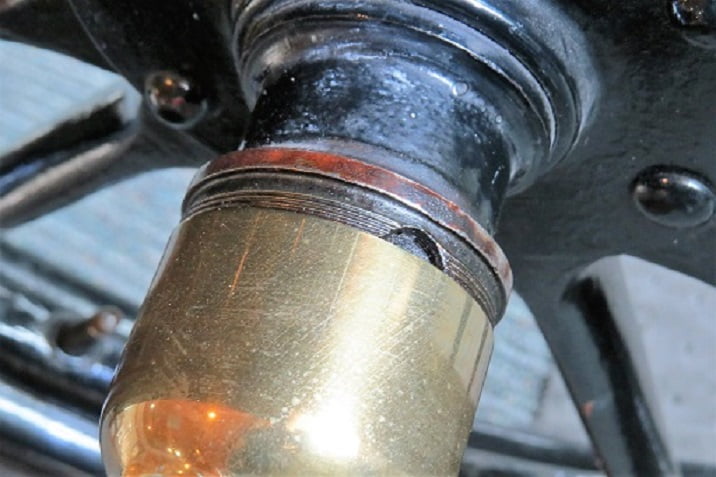
The hubcaps are not just decorative. This photo above shows the hubcap partly unscrewed to reveal the axle pin below. The round pin, combined with a square key fitted to a keyway cut in both the hub and the axle secure the wheel to the car. The hubcap keeps the pin or the key from falling out. The front hubcaps were entirely filled with grease.

The earliest hubcap wrench has nothing that fits the nut on the rear axle because there was no nut on the rear axle prior to February 1911.
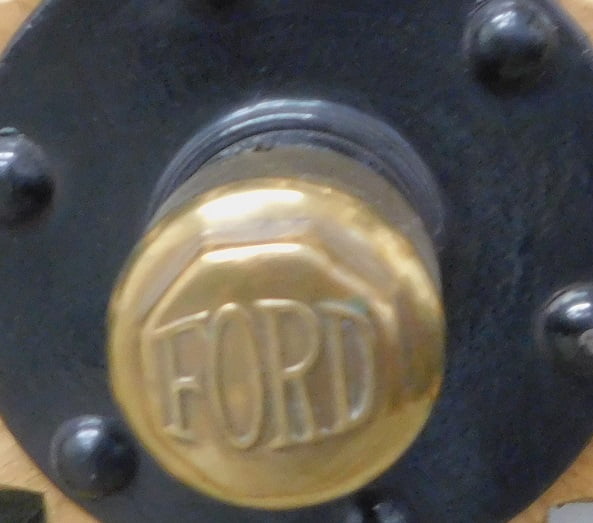
This is an older reproduction of the 1909 – 1910 hubcap. These were used until late fall of 1910.
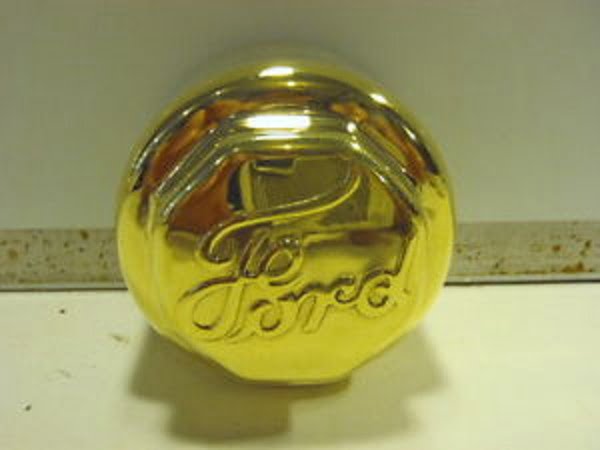
Beginning about October 1910 the hubcaps began to appear with “Ford” in the familiar script on a plain background. This is a photo above showing a modern reproduction. It is fairly faithful to the original.

The car shown above is an early 1912 Model T that was used in testing of the magneto powered headlamps. This photo and the one below were shot in the shipping area of the Highland Park plant in the late summer of 1914. In the background are lines of new “1915” couplets and tudor sedans.


You can see the new “1912” hubcaps clearly in a cut from the original glass plate negative. The Ford Script is now on a painted black background with a raised lip around the outer edge of the hubcap.

Above, an original “1912” hubcap. The record of change for the hubcap drawing shows July 13, 1911 as the revision date. Hubcaps of this design would have been standard at the beginning of the 1912 model year which was October 1, 1911. The background was painted black originally.

This is a much later 1912 touring, now with “Fore Doors” on the late 1912 “slab side” body. Henry Ford is at the wheel in this spring 1912 photo with his uncle Henry. We don’t know who the woman or the child might be.

A close up view of the wheel on the car shows again the typical “1912” hubcap with black background surrounding the Ford script and the raised lip around the circumference. The wheel pin striping shown is quite typical of 1909 – 1913.
According to the record of changes on April 16, 1912 the words “Made In U.S.A.” were now to be “stamped” on the hubcaps below the Ford script and the background of the hubcap was to be black oxidized.
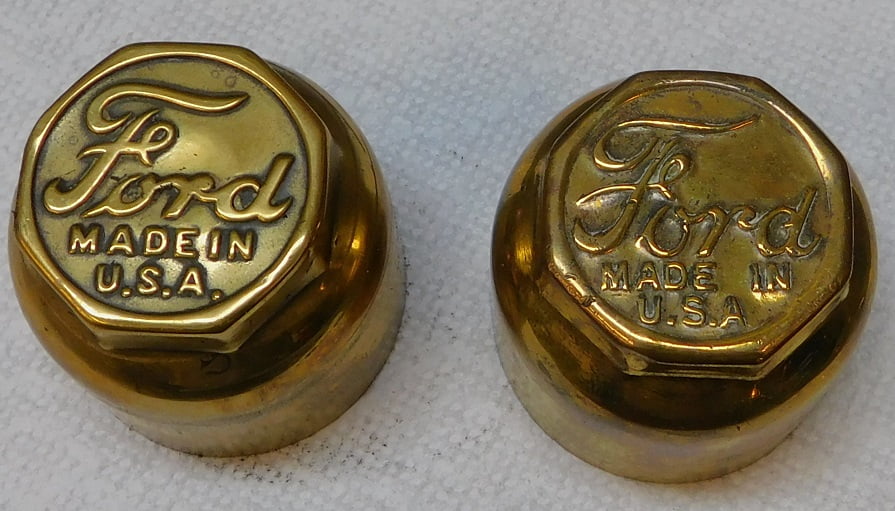
Above are two variations of the so called “High F” hubcaps used from 1912 – 1916. The background around the letters was black oxidized in all cases.

Above, a 1914 factory photo shows a new 1915 center door sedan with the “High F” 1912 – 1916 brass hubcap. Again, the background of every hubcap was black around the lettering, something which most restorers get wrong.

Above is a reproduction 1912 – 1916 hubcap as sold by many of the Model T part vendors. These have been made since the 1950’s with varying quality and detail. They are easily spotted now that you know what to look for.

Above is a photo of the completely restyled 1917 Model T touring introduced on August 1, 1916. Gone are all traces of brass trim. Now the hubcaps are nickel plated to make the new Ford as stylish as possible.

Close up cut from the original glass plate negative shows the nickel plated hubcap with its black background. Again, this is a detail missing in most restorations.

Above is an original nickel plated hubcap as used in 1917 – 1919 model years. The record of change shows the nickel plating was applied over a steel hubcap; however this hubcap happens to be made of brass with nickel plating. As before, the background is black oxide in the center of the lettered area. A small “B” is below the Ford Made In U.S.A. script. This is thought to be a maker’s mark.

From the early 19 – teens there was a thriving aftermarket industry surrounding the Model T Ford. You could buy a replacement of virtually any part of a Model T that was not made by Ford at a cheaper price. The typical Ford owner was known to be a miserly penny pincher! The hubcaps were not an exception. The plain hubcap above is made from brass plated steel. Such hubcaps were offered by companies like JC Whitney, Western Auto, and Gambles Department Stores to name only a few.


Above, the same cheapie steel hubcaps were also offered with nickel plating to match the more modern 1917 – 27 Ford.
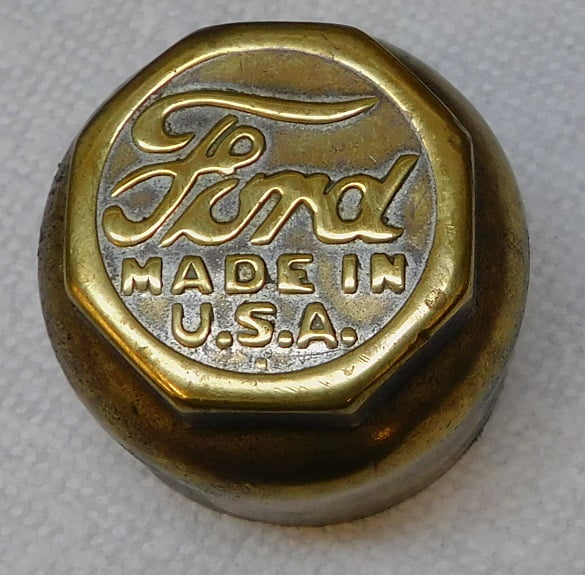
In 1920 the hubcap styling was revised with a thicker raised lip around the outer edge. Nickel plating continued with the hubcap material being brass. The background is now plain with no black oxide finish. The cap shown above is an original from this era, with nearly all the nickel plating gone in many areas. This design was continued for wood wheeled cars through the end of Model T production in 1927 for wood wheeled cars and the front wheels of the TT truck. There are notations that state a polished zinc hubcap may have been used however this author has yet to see one, so perhaps it was a short – lived experiment.

Ford completely restyled the Model T in 1926 with the introduction of the “Improved” Model T Ford. Wire wheels were now optional in a choice of three colors black, straw, or red. The new style wheels had a new hubcap design that is retained by bending over small tabs on the inside of the wheel center.
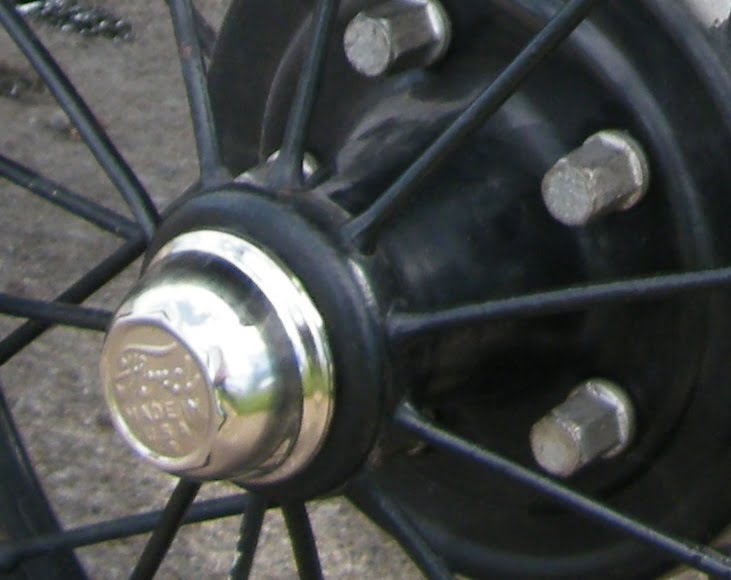
Above is the final design of the Model T Ford hubcap as used with wire wheels. This one happens to be a reproduction. The hubcaps were nickel plated. Lug nuts were zinc plated.
